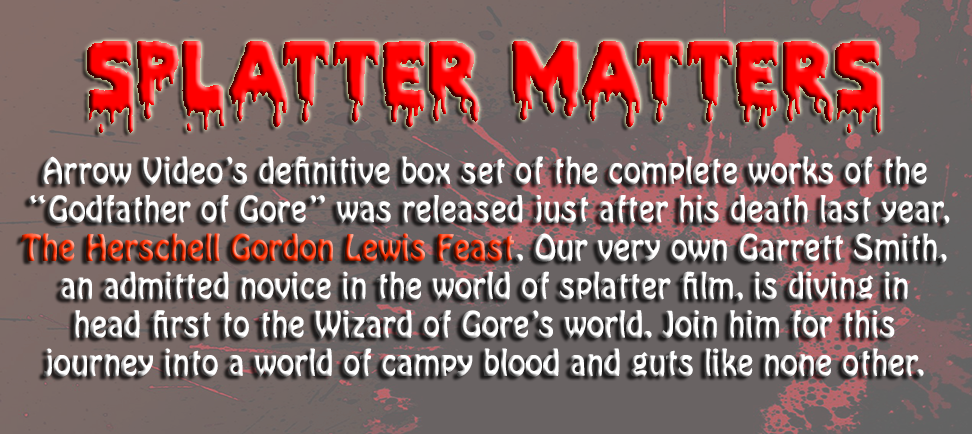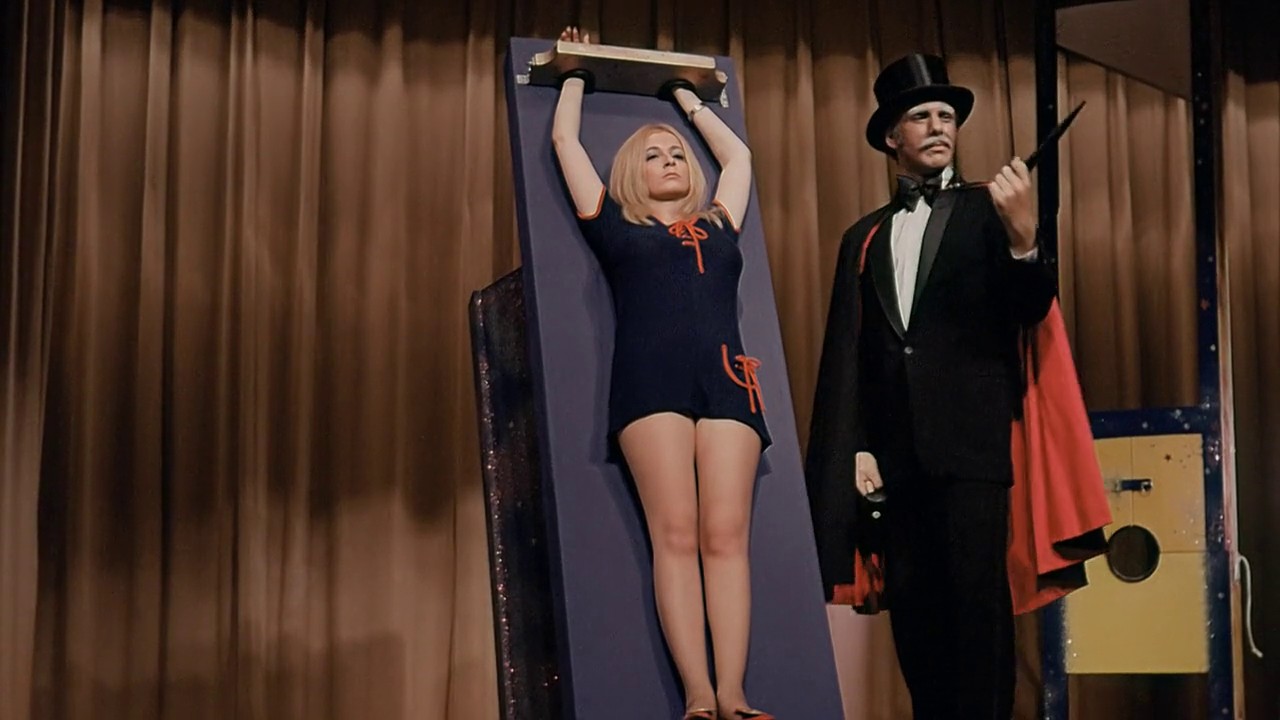Splatter Matters: THE WIZARD OF GORE Makes a Solid Case for Splatter

Previously on Splatter Matters:
I got back into the swing of things with ol’ Herschell after he made a movie about a clown car (as far as I’m concerned, that’s what How to Make a Doll is about) and it cleared the bad taste left in my mouth from some of his previous efforts. I am renewed and ready for whatever the master of schlock has to throw at me.
And that brings me to the crown jewel that I’ve been waiting to watch, the movie that made me want to do this series in the first place, The Wizard of Gore. It’s easy to see why this movie has achieved the cult status it has – it’s the goriest of his movies by far, has a memorable twist ending of sorts, and has a premise that doesn’t end with a bunch of raped and murdered women (just murdered). By leaving his taste for sexual exploitation behind and instead focusing on the gore FX and the characters, he made a movie that actually has structure and drama that keeps you invested throughout. That’s not to say his previous efforts were always lacking these things, but there was a period there where he was definitely more interested putting women in compromising scenarios than he was telling a story.

The Wizard of Gore is about a magician, Montag The Magnificent, who hypnotizes his audience into thinking they’re seeing real murder on stage – or is it truly hypnotism? The premise allows for all kinds of insanity, like doing the “saw a woman in half” trick, but having the woman on an open table rather than in an enclosed box and literally sawing her in half with a fucking chainsaw. Once the trick is over, the hypnosis is lifted and the audience sees that the person they just watched get brutally murdered in front of their eyes is perfectly fine. That is of course, until later that evening when the injuries reappear and each of his audience volunteers dies. As the bodies pile up, a TV personality, Sherry Carson (Judy Cler) and her sports journalist boyfriend become obsessed with Montag and try to unravel they mystery of his show, going so far as to invite him to perform on Carson’s TV program. This gives Montag the platform he needs to commit a mass murder of anyone watching him through hypnosis, only to ultimately be stopped by Carson herself when, in a final twist of fate, she reveals she is a witch and has been hypnotizing him all along, making him think he’s been pulling off his dastardly plans when really he is still just performing the first show we see him at in the beginning of the movie. It’s not a great twist and doesn’t really make a lot of sense, but it’s a far more memorable ending than I’m used to with HGL’s movies and must have something to do with this movie’s legacy.
The filmmaking here is very bizarre, and I’m not convinced the twist ending really explains any of it. During Montag’s tricks, where he straight up murders people on stage, the editing is really wild. From shot to shot, his victim might be totally bloody and disgusting, and then look as if they haven’t been touched, and then back to bloody again. And although he cuts to the audience throughout, we never get any kind of reaction from them. It’s always shots of them just sitting comfortably and staring forward. While that may be his way of trying to depict hypnotism, I can’t help but think these scenes would have played better if we saw the audience reacting in real ways to what they’re seeing, only to in the end have the volunteer that was brutally murdered appear totally fine to them, leaving them in wonderment. As it is, these sequences are more confusing than anything, albeit with some awesome gore FX. And by awesome I mean cheap as hell, frequently ineffective, but occasionally truly great. There’s a sword swallowing trick that I really have no idea how HGL pulled off, and another one where a machine press punches a hole through a woman that looks better than anything he’s done previously. At the end of the day, this movie works because it’s kind of fun in the disturbing ways HGL’s movies can sometimes be.
There’s also an added layer to this movie that a lot of Lewis’ work does not seem to have and likely lends to its legacy. I’ll let him explain it:
It did well at the box office. Others have tried to match its success. Some misunderstood what the intentions were for THE WIZARD OF GORE. It’s a satire! We are dealing in a category that not only defies definition – we don’t want it! We want people to have seen THE WIZARD OF GORE and say, if nothing else, ‘what was that?’
First of all, Herschell, I hate to break it to you, but satire does indeed have a definition. That said, there is a layer of satire in this movie, though based on his own lack of understanding of what satire is, it’s a bit muddled. As dead bodies are discovered throughout the movie, characters comment on the sensationalizing of violence in the media. They bring up how violent TV has become and the influence that’s having on already sick minds. At one point, the detectives on the case even suppose that Montag’s tricks are giving a madman in his audience ideas about how to kill people, as well as targets, essentially saying that Montag’s media is the cause for the killings. I would buy this as decent satire, since we are in fact watching a movie about all of this where characters are kind of admonishing us against doing so, kind of proving that it’s a bullshit accusation to say media illicit violent behavior in people. But then in the end it turns out Montag’s grand plan is to get himself on TV and use that platform to hypnotize people en masse and get them to kill themselves. This kind of deflates that satire for me, as now the thing he was seemingly calling bullshit on is the finale of his movie, where something on TV literally does illicit violence in people. All that said, this certainly adds a thematic edge to this movie that most of his work is lacking, and that probably contributes to the film’s reputation.

It’s interesting to note that Montag is played by a frequent HGL collaborator, Ray Sager. He’s familiar to me from some of Herschell’s previous movies, though the only HGL acting credit I can find for him is in The Gruesome Twosome, and according to Herschell’s introduction to The Wizard of Gore on The HGL Feast Box Set from Arrow Video, Sager worked behind the scenes on a lot of his movies, occasionally getting to step into small roles on camera when needed. As Herschell tells it, Sager was not intended to play Montag in this movie. But when, on the first day of shooting, just before they rolled camera for the first time, their lead actor demanded to be paid more, Lewis and his producer decided instead to fire that actor and ask Sager, who was pulling cable behind the scenes, if he would like to star in the movie. You’re reading that correctly – the star of this movie got given the part on the day they started shooting. That is far and away the most “Herschell” thing Herschell has done over the course of this series.
And with that my friends, we return to that age old question – does Splatter Matter? The Wizard of Gore might be the definitive proof that it very much does. This is a movie that pushes the boundaries of taste so as to ask questions about our relationship with violence and media. It may not have discernible answers to those questions, but these are questions that continue to plague us today, giving this movie a continued relevance almost 50 years later. And by being the kind of media it’s asking questions about, it becomes an ironic litmus test of sorts, asking us if we truly feel any more inclined to violence after having seen it.
My, my, Herschell, perhaps this is a brilliant bit of satire after all.





